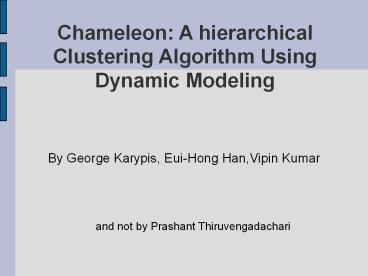Chameleon: A hierarchical Clustering Algorithm Using Dynamic Mo - PowerPoint PPT Presentation
Title:
Chameleon: A hierarchical Clustering Algorithm Using Dynamic Mo
Description:
Chameleon: A hierarchical Clustering Algorithm Using Dynamic Modeling ... Algorithm assigns K-representational points to ... yucky and reasonably yucky parts. ... – PowerPoint PPT presentation
Number of Views:1465
Avg rating:3.0/5.0
Title: Chameleon: A hierarchical Clustering Algorithm Using Dynamic Mo
1
Chameleon A hierarchical Clustering Algorithm
Using Dynamic Modeling
- By George Karypis, Eui-Hong Han,Vipin Kumar
- and not by Prashant Thiruvengadachari
2
Existing Algorithms
- K-means and PAM
- Algorithm assigns K-representational points to
the clusters and tries to form clusters based on
the distance measure.
3
More algorithms
- Other algorithm include CURE, ROCK, CLARANS, etc.
- CURE takes into account distance between
representatives - ROCK takes into account inter-cluster aggregate
connectivity.
4
Chameleon
- Two-phase approach
- Phase -I
- Uses a graph partitioning algorithm to divide the
data set into a set of individual clusters. - Phase -II
- uses an agglomerative hierarchical mining
algorithm to merge the clusters.
5
So, basically..
6
- Why not stop with Phase-I? We've got the
clusters, haven't we ? - Chameleon(Phase-II) takes into account
- Inter Connetivity
- Relative closeness
- Hence, chameleon takes into account features
intrinsic to a cluster.
7
Constructing a sparse graph
- Using KNN
- Data points that are far away are completely
avoided by the algorithm (reducing the noise in
the dataset)? - captures the concept of neighbourhood dynamically
by taking into account the density of the region.
8
What do you do with the graph ?
- Partition the KNN graph such that the edge cut is
minimized. - Reason Since edge cut represents similarity
between the points, less edge cut gt less
similarity. - Multi-level graph partitioning algorithms to
partition the graph hMeTiS library.
9
Example
10
Cluster Similarity
- Models cluster similarity based on the relative
inter-connectivity and relative closeness of the
clusters.
11
Relative Inter-Connectivity
- Ci and Cj
- RIC AbsoluteIC(Ci,Cj)?
- internal IC(Ci)internal IC(Cj) / 2
- where AbsoluteIC(Ci,Cj) sum of weights of edges
that connect Ci with Cj. - internalIC(Ci) weighted sum of edges that
partition the cluster into roughly equal parts.
12
Relative Closeness
- Absolute closeness normalized with respect to the
internal closeness of the two clusters. - Absolute closeness got by average similarity
between the points in Ci that are connected to
the points in Cj. - average weight of the edges from C(i)-gtC(j).
13
Internal Closeness.
- Internal closeness of the cluster got by average
of the weights of the edges in the cluster.
14
So, which clusters do we merge?
- So far, we have got
- Relative Inter-Connectivity measure.
- Relative Closeness measure.
- Using them,
15
Merging the clusters..
- If the relative inter-connectivity measure
relative closeness measure are same, choose
inter-connectivity. - You can also use,
- RI (Ci , C j )T(RI) and RC(C i,C j ) T(RC)?
- Allows multiple clusters to merge at each level.
16
Good points about the paper
- Nice description of the working of the system.
- Gives a note of existing algorithms and as to why
chameleon is better. - Not specific to a particular domain.
17
yucky and reasonably yucky parts..
- Not much information given about the Phase-I part
of the paper graph properties ? - Finding the complexity of the algorithm
- O(nm n log n m2log m)?
- Different domains require different measures for
connectivity and closeness, ...................
18
Questions ?































